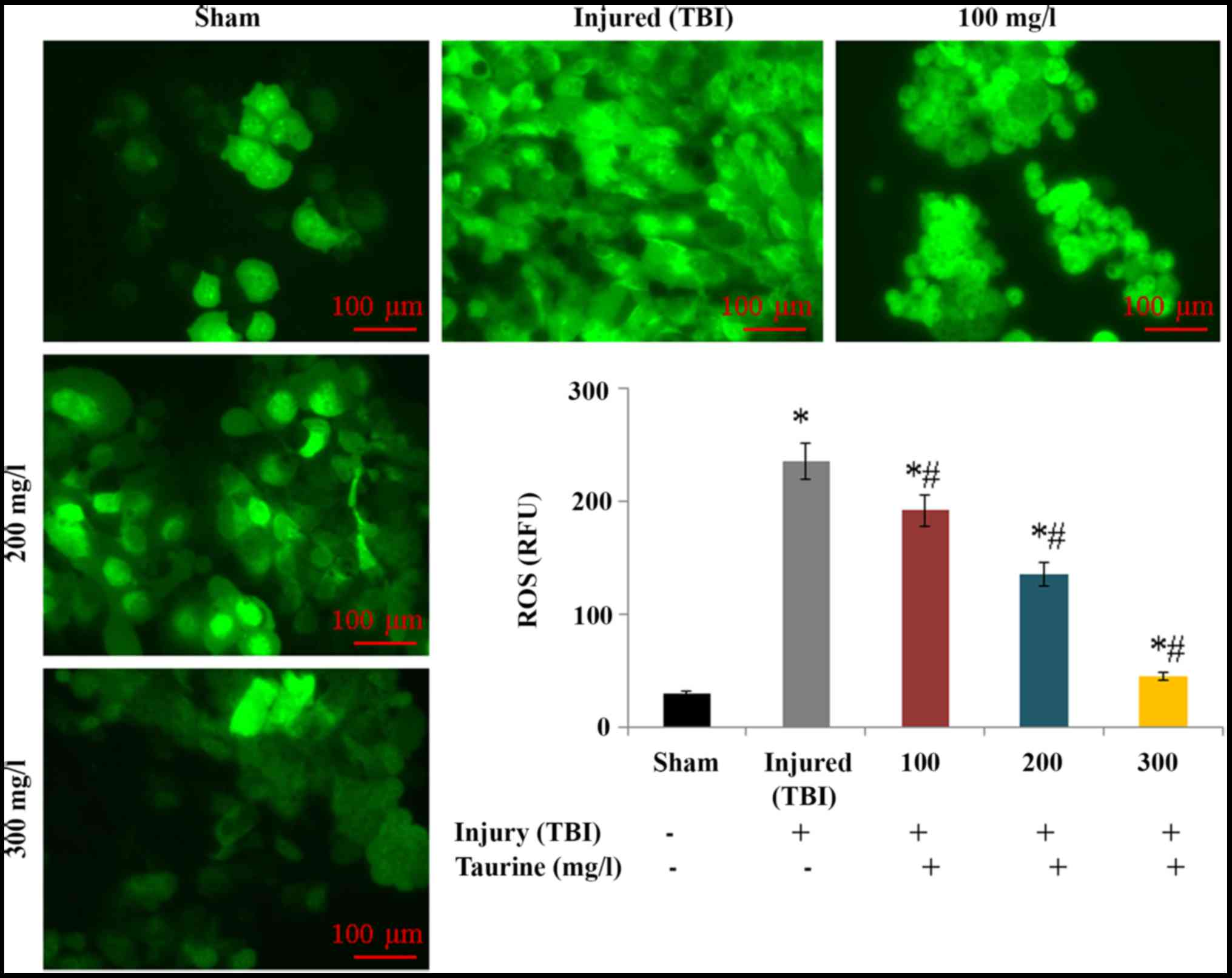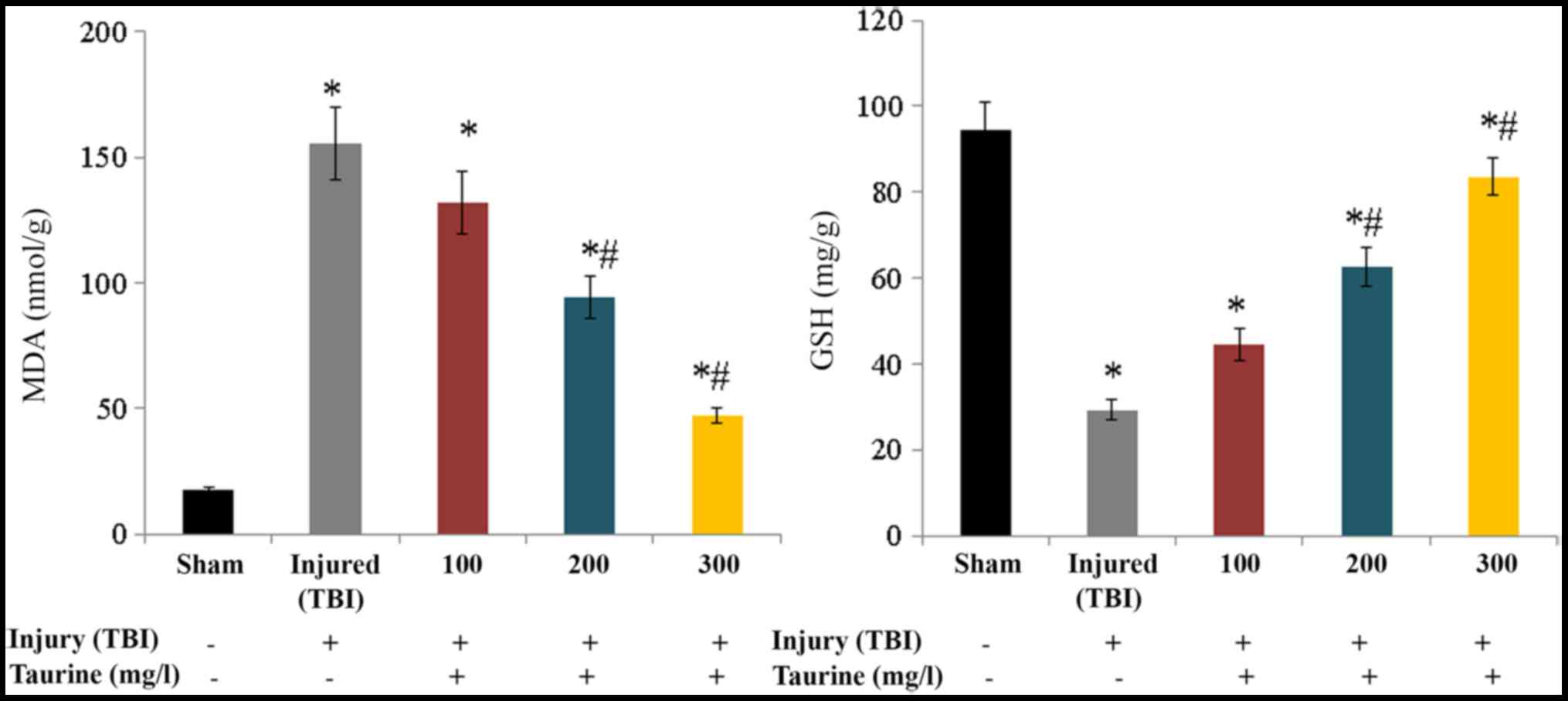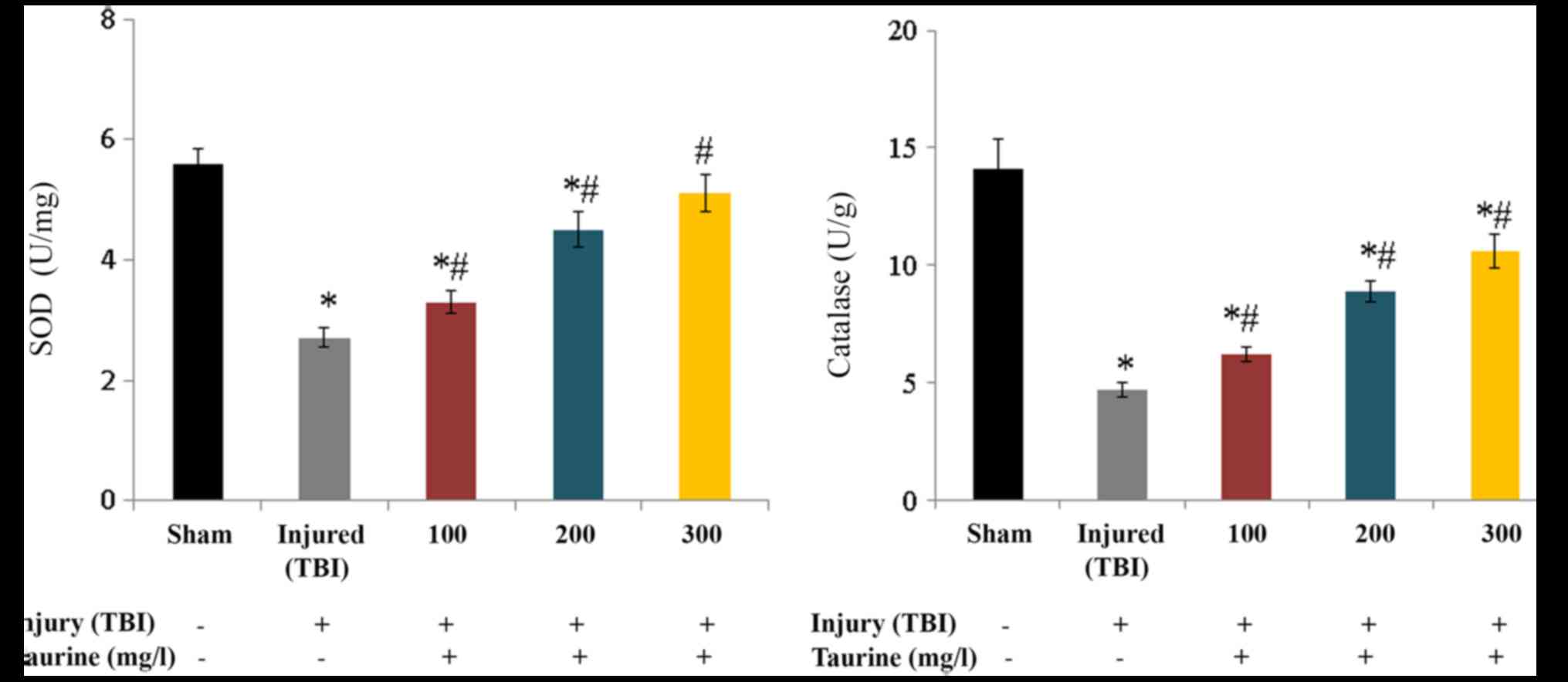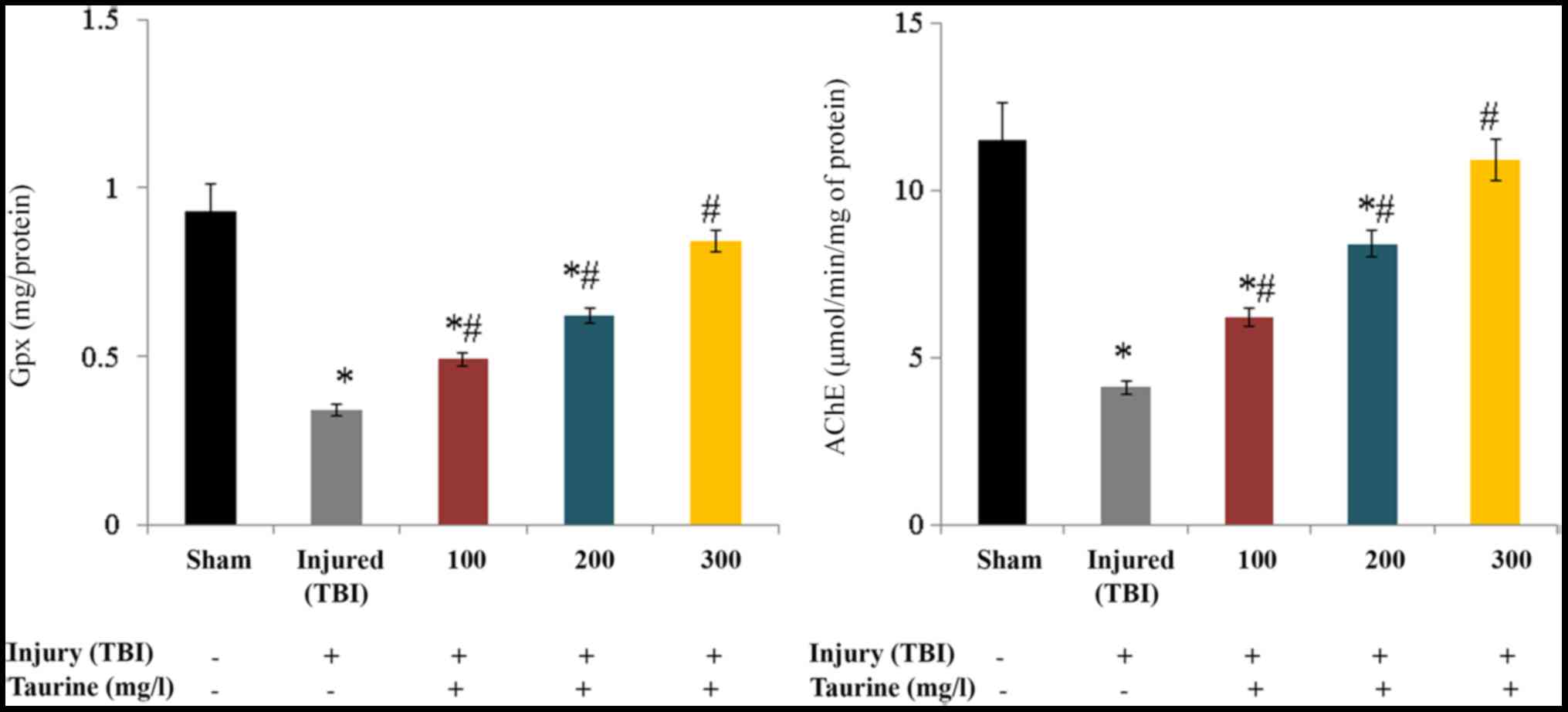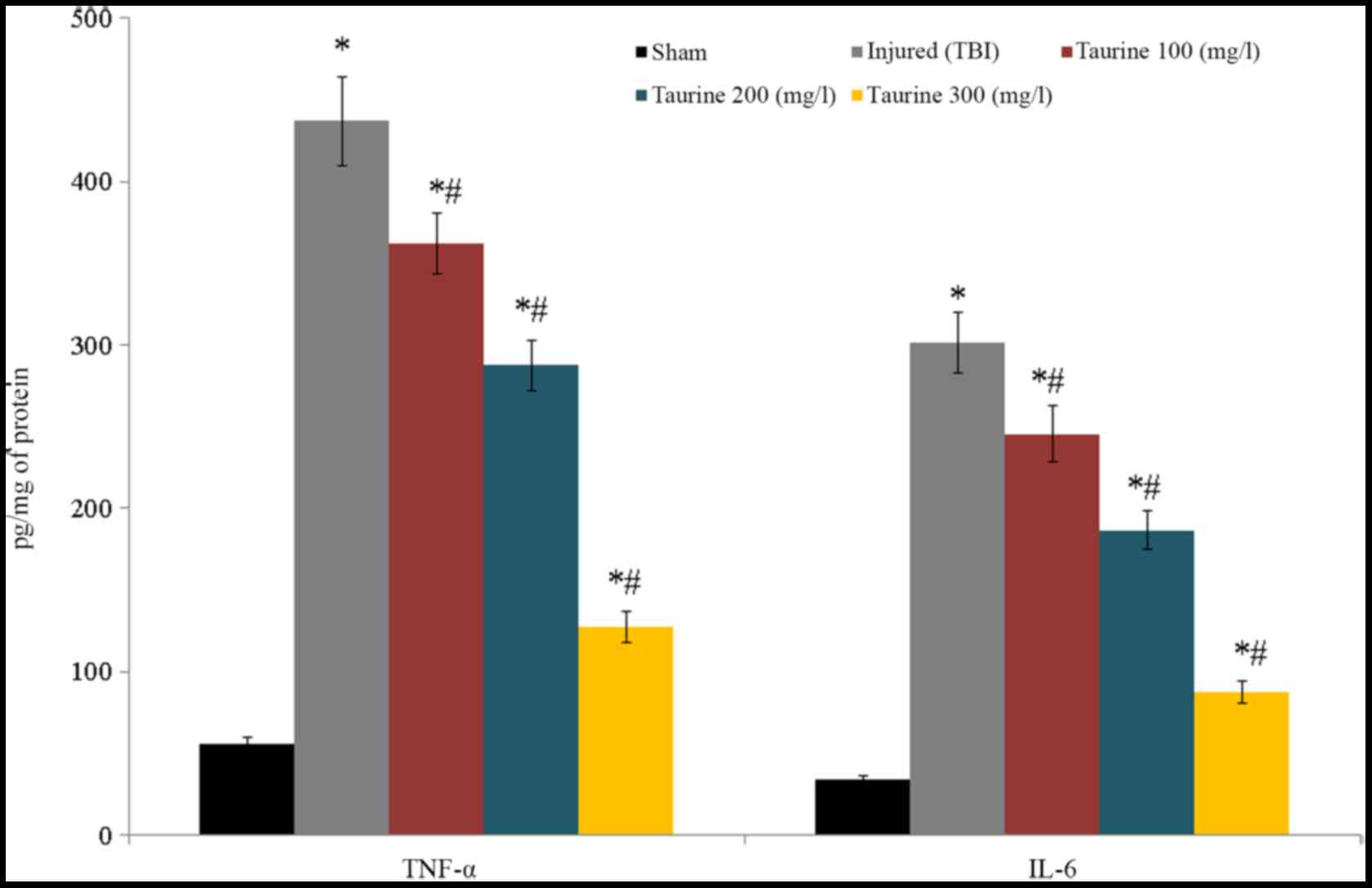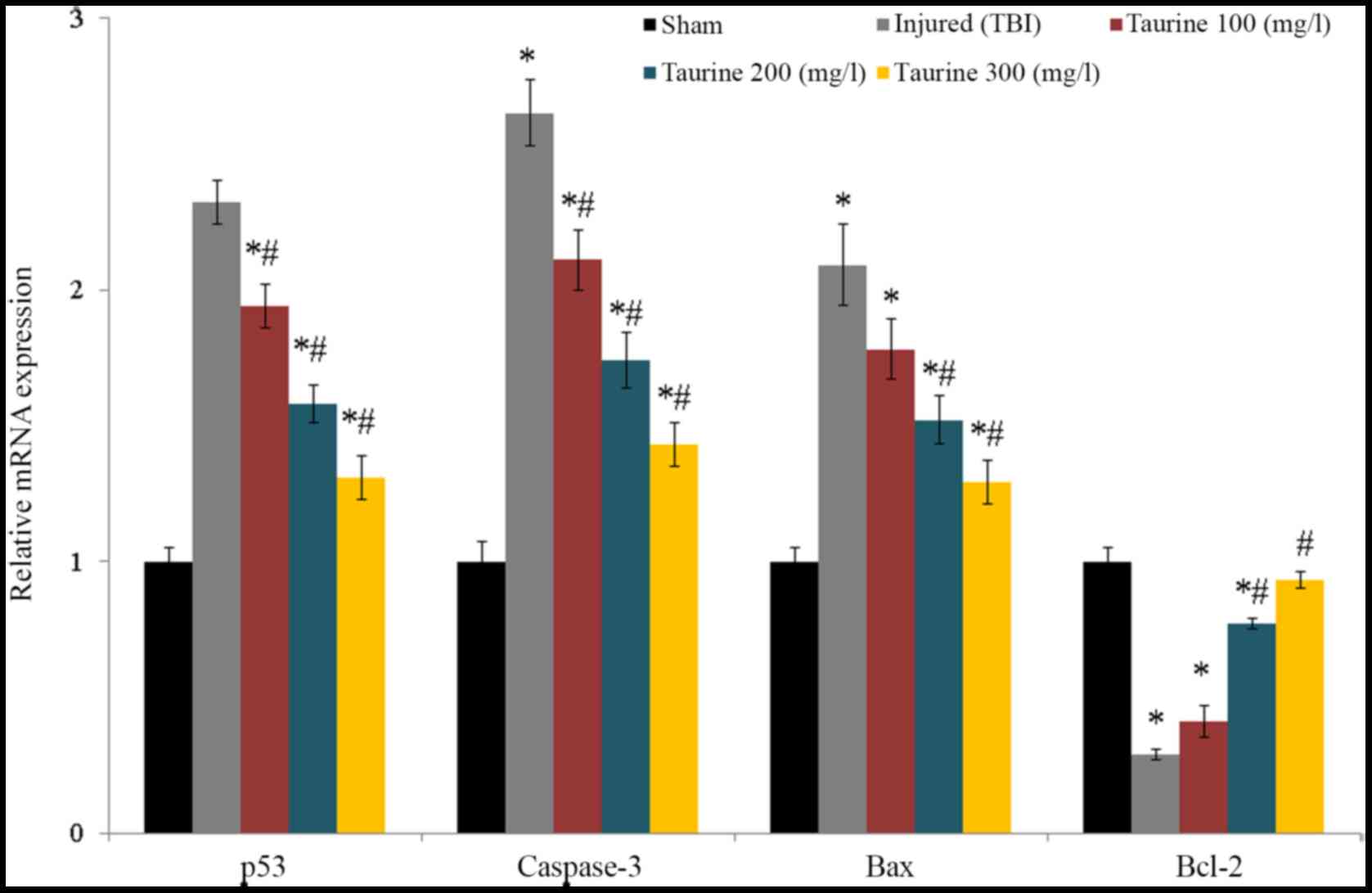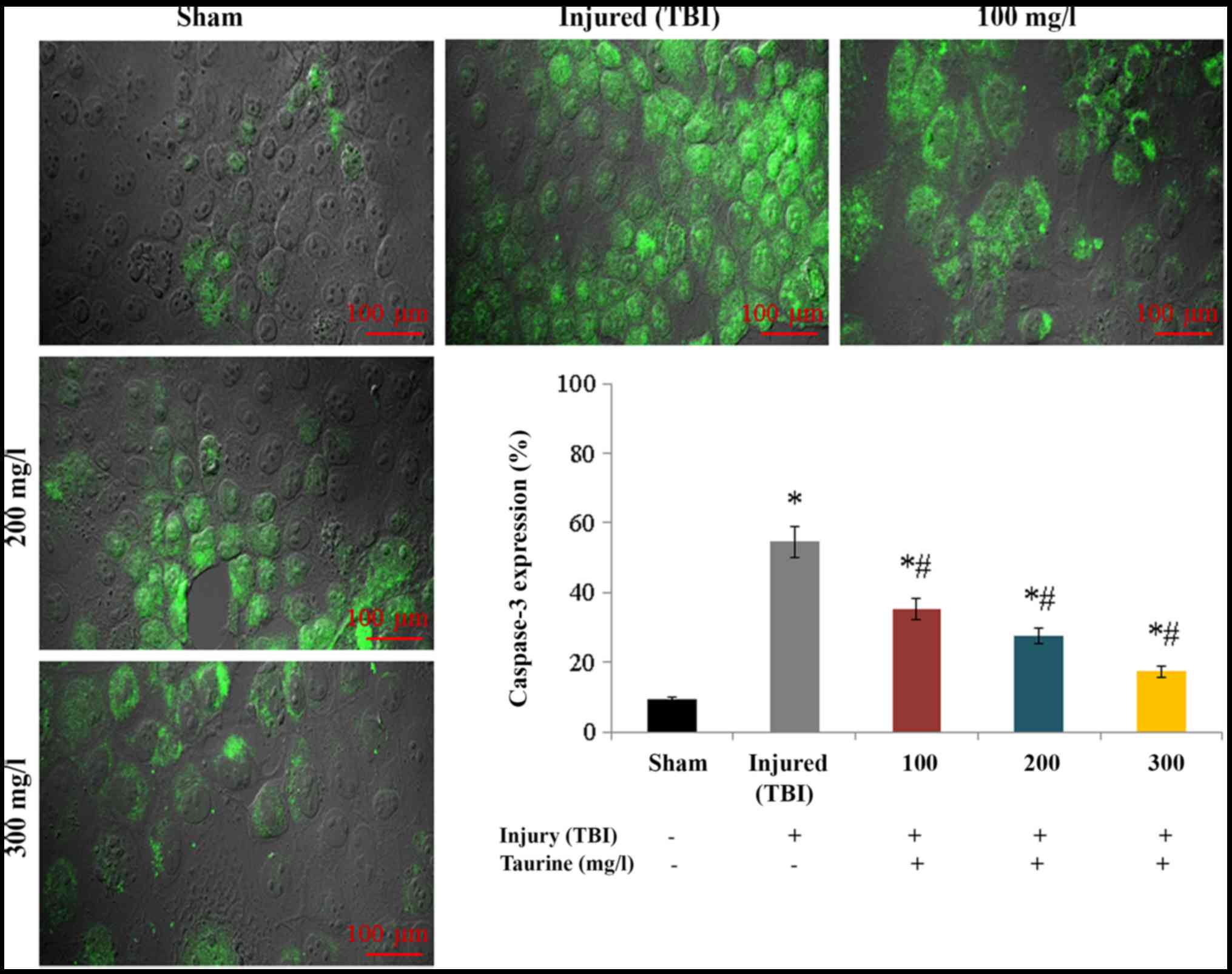Protective effects of taurine against inflammation, apoptosis, and oxidative stress in brain injury
- Authors:
- Published online on: September 6, 2018 https://doi.org/10.3892/mmr.2018.9465
- Pages: 4516-4522
-
Copyright: © Niu et al. This is an open access article distributed under the terms of Creative Commons Attribution License.
Abstract
Introduction
Taurine is a non-proteogenic and essential amino acid in animals (1), and is known to play a critical nutritional role in brain cell growth, differentiation, and development (2). Huxtable (3) have reported on the functional role of taurine in the central nervous system, as well as its functions in cardiovascular and skeletal muscle. Rak et al (4) demonstrated that taurine plays a key role in regeneration and neuroprotection in the injured nervous system. Taurine is an effective antioxidant against lead-, cadmium-, and exercise-induced oxidative stress (5), and is known to reduce the secretion of lipids and apolipoprotein B100 in liver cancer cells (6). Taurine is also invovled in neurotransmission, detoxification, osmoregulation, calcium homeostasis, obesity prevention, excitotoxicity, osmotic shock recovery, and prevention of seizures (7–13).
Traumatic brain injury (TBI) leads to cognitive deficits, high mortality, and impaired movement (14). The most common cause of TBI is external force to the brain, and it can be classified as closed or penetrating head injury (15). Ischemia, oxidative stress, apoptosis, inflammation, excitotoxicity, and vascular and neuronal damage may also cause TBI (16,17). Lotocki et al (18) reported that inflammation is a well-known critical event in TBI, which may be mediated by the secretion of cytokines and activation of glial cells. Taurine supplementation may substantially reduce inflammatory cytokines, such as tumor necrosis factor (TNF)-α, interleukin (IL)-6, and IL-1β, in spinal cord injury (19). Heidari et al (20) reported a protective effect of taurine against acute and chronic liver injuries. Recently, Wang et al (2) investigated the protective role of taurine against TBI. In the present study, we investigated the therapeutic effect of taurine on levels of ROS, malondialdehyde (MDA), reduced glutathione (GSH), glutathione peroxidase (Gpx), superoxide dismutase (SOD), catalase, acetylcholinesterase (AChE), TNF-α, IL-6, caspase-3, p53, bcl-2 and bax in injured brain cells.
Materials and methods
Animals
Twenty-four male albino Wistar strain neonatal rats were obtained from The Second Affiliated Hospital of Xi'an Jiaotong University (Xi'an, China). The rats weighed 5–10 g and were allowed free access to water and food with a 12-h light and dark cycle. Rats were sacrificed by decapitation following intraperitoneal administration of ketamine hydrochloride (80 mg/kg) and xylazine (10 mg/kg). All experiments involving rats were monitored and approved by the ethics committee of The Second Affiliated Hospital of Xi'an Jiaotong University (Ref no. 2o14/2Tx1221).
Cell culture
Cortical tissues were isolated from embryonic day 15 rats and disassociated. Separated cells were cultured at a density of 1.5×103 cells/ml on existing astrocyte cell cultures. Co-cultures of astrocytes and neuron cells were prepared as previously described (21). The co-culture was supplemented with standard growth medium containing 10% fetal bovine serum and Dulbecco's modified Eagle's medium.
Experimental traumatic brain cell injury model
Experimental traumatic brain cell injury was induced according to Katano et al (22). Traumatic model cells were supplemented with G5 (2%) for 12 h before the induction of injury. The mechanical injury was induced using a standard scratch method (23), and standard scratches were made in 6-well plates. Cells were supplemented with standard growth medium. After 24 h, cell survival was evaluated as lactate dehydrogenase activity (ab102526; Abcam, Cambridge, UK).
Taurine treatment and sample collection
Cells were treated with 100, 200, or 300 mg/l of taurine (ab141063; Abcam) for 72 h. Following treatment, the medium was removed carefully and the cells were washed with phosphate buffered saline. The cells were collected, centrifuged, and stored at −80°C.
Oxidative markers
ROS level was measured by the incubation of cells with dichloro-dihydro-fluorescein diacetate (DCFH-DA) for 30 min, and fluorescence was measured under a fluorescence plate reader (24). The MDA content in the cell supernatant was determined by measuring thiobarbituric acid reactive species (TBARS). Briefly, the reaction tube contained 0.1 ml of cell culture supernatant, thiobarbituric acid (1.5 ml), 0.2 ml of sodium dodecyl sulfate (SDS), and acetic acid (1.5 ml). The resultant upper layer product was measured at 534 nm (24). GSH levels were determined based on Ellman's reaction. The absorbance was measured at 412 nm (24). Gpx activity was measured by adding 0.2 ml of Tris-HCl buffer, 0.2 ml of GSH, 0.1 ml of H2O2, 0.2 ml of homogenate, and sodium azide (0.1 ml) to the reaction tube. The reaction tube was centrifuged for 10 min at 3,000 × g. Then, cell culture supernatant (0.2 ml) and Ellman's reagent (0.1 ml) were added to the reaction tube, and the final absorbance was measured at 340 nm (25).
SOD activity was determined by adding cell culture supernatant (0.1 ml), nitro blue tetrazolium (0.3 ml), NADH (0.2 ml) and sodium phosphate buffer (1.2 ml). The final absorbance was measured at 560 nm (25). Catalase activity was determined by adding phosphate buffer (500 µl), cell culture supernatant (500 µl) and H2O2 (500 µl). Then, TiOSO4 (500 µl) was added to the reaction tube, and the final absorbance was measured at 420 nm (25). AChE activity was determined by the addition of acetylcholine (0.02 ml), cell culture supernatant (0.02 ml), DTNB (0.1 ml) and phosphate buffer (3 ml) into the reaction tube. The final absorbance was measured at 410 nm (26).
Inflammatory markers
TNF-α and IL-6 levels were determined in the cell culture were determined by enzyme-linked immunosorbent assay (RAB0141-1KT, Mouse ELISA kit; Sigma-Aldrich China, Inc., Shanghai, China) (27–29).
Apoptosis markers
For the reverse transcription-quantitative polymerase chain reaction (RT-qPCR) assay, RNA was isolated from the cells and converted into cDNA using oligo (dT) primers. Then, qPCR was used to quantify the mRNA expression with primers specific for caspase-3, p53, bcl-2 and bax (Table I). Glyceraldehyde 3-phosphate dehydrogenase (GAPDH) was used as a qPCR internal control. The 2−∆∆Cq method was used to calculate the relative ratios of expression (30). Caspase-3 protein expression was determined by immunofluorescence staining according to Lobos et al (31) and images were taken under fluorescence microscope (IX73 Inverted Microscope; Olympus Corporation, Tokyo, Japan).
Statistical analysis
Values are given as mean with standard deviations. Differences between the control and taurine groups were evaluated using the unpaired Student's t-test. One-way ANOVA was applied for statistical analysis of data and post hoc Tukey's test was used for multiple comparisons. P<0.05 was considered to indicate a statistically significant difference.
Results
Effect of taurine on oxidative markers
The protective effect of taurine against inflammation, apoptosis, and oxidative stress in TBI was investigated in this study. Intracellular ROS levels were substantially increased to 234.52 relative fluorescence units (RFU) in injured brain cells. However, taurine supplementation significantly reduced ROS levels to 191.1 (100 mg/l), 135.24 (200 mg/l), and 44.72 RFU (300 mg/l) in injured brain cells (P<0.05; Fig. 1). Lipid peroxidation was substantially increased to 155.32 nmol/g in injured brain cells. Taurine supplementation significantly reduced lipid peroxidation to 131.87 (100 mg/l), 94.61 (200 mg/l), and 47.3 nmol/g (300 mg/l) in injured brain cells (P<0.05; Fig. 2). GSH content was substantially reduced to 29.25 mg/g in injured brain cells, while taurine supplementation significantly increased GSH content to 44.46 (100 mg/l), 62.63 (200 mg/l), and 83.56 mg/g (300 mg/l) in injured brain cells (P<0.05; Fig. 2).
SOD activity was substantially reduced to 2.7 U/mg in injured brain cells. Taurine supplementation significantly increased SOD activity to 3.3 (100 mg/l), 4.5 (200 mg/l), and 5.1 U/mg (300 mg/l) in injured brain cells (P<0.05; Fig. 3). Catalase activity was substantially reduced to 4.7 U/g in injured brain cells. Taurine supplementation significantly increased catalase activity to 6.2 (100 mg/l), 8.9 (200 mg/l), and 10.6 U/g (300 mg/l) in injured brain cells (P<0.05; Fig. 3). Gpx activity was substantially reduced to 0.34 mg/protein in injured brain cells. Taurine supplementation significantly increased Gpx activity to 0.49 (100 mg/l), 0.62 (200 mg/l), and 0.84 mg/protein (300 mg/l) in injured brain cells (P<0.05; Fig. 4). AChE activity was substantially reduced to 4.1 µmol/min/mg of protein in injured brain cells. Taurine supplementation significantly increased AChE activity to 6.2 (100 mg/l), 8.4 (200 mg/l), and 10.9 µmol/min/mg of protein (300 mg/l) in injured brain cells (P<0.05; Fig. 4).
Effect of taurine on inflammatory markers
TNF-α and IL-6 levels were substantially reduced to 437.12 and 301.5 pg/mg of protein, respectively, in injured brain cells. Following taurine treatment, TNF-α levels were decreased [362.11 (100 mg/l), 287.45 (200 mg/l), and 127.25 pg/mg of protein (300 mg/l)], while IL-6 levels were increased [245.6 (100 mg/l), 186.5 (200 mg/l), and 87.5 pg/mg of protein (300 mg/l)] in injured brain cells (P<0.05; Fig. 5).
Effect of taurine on apoptosis markers
Taurine supplementation significantly reduced p53, caspase-3, and bax mRNA expression and increased bcl-2 mRNA expression in injured brain cells (P<0.05; Fig. 6). Protein expression of caspase-3 increased to 54.51% in injured brain cells compared to normal brain cells. Taurine supplementation substantially reduced caspase-3 protein expression to 35.31 (100 mg/l), 27.48 (200 mg/l), and 17.3% (300 mg/l) (P<0.05; Fig. 7).
Discussion
This study investigated the protective effect of taurine against inflammation, apoptosis, and oxidative stress in TBI. Taurine supplementation has been shown to substantially reduce infarct volume, brain swelling, cell death, and neurological deficits in a stroke-induced rat model (32). Taurine also significantly reduced apoptosis in cardiomyocytes of rats (33). Sun et al (34) also reported a protective effect of taurine against head injury. Several researchers have associated mitochondrial dysfunction with increased ROS and superoxide production, glutathione oxidation, and reduced antioxidant enzymes (2).
Taurine increases antioxidant activity by reducing superoxide production, which leads to improved mitochondrial function (35). Taurine also plays a crucial role in protein synthesis in mitochondria, and increases electron transport chain (ETC) activity (36). Our experimental results indicate that taurine increases antioxidant levels through increased mitochondrial ETC activity in TBI.
Mitochondrial dysfunction leads to increased production of oxidants, which leads to neuronal apoptosis and necrosis. Mitochondrial respiratory chains present on the inner mitochondrial membrane contain four transmembrane protein complexes. Chen and Chan (37) observed energy metabolism dysfunction associated with pathological changes in mitochondria following TBI. Several researchers have found that respiratory enzyme levels were decreased following traumatic and ischemic brain injury (38,39). Zhu et al (40) have illustrated the incidence of gastrointestinal dysfunction in TBI. Mitochondrial dysfunction can increase the production of oxidants, which play a crucial role in apoptosis and necrosis of neurons. Proapoptotic markers, such as bcl-2, increase in response to increased oxidants produced in brain injury. Apoptosis is induced through increased oxidants and misfolded proteins (41). Increased production of reactive oxygen species (ROS) and superoxide, glutathione oxidation, and reduced antioxidant enzymes have been associated with mitochondrial dysfunction (2,42–45). Vlodavsky et al (46) postulated that post-traumatic cytotoxic edema is associated with mitochondrial function. Sun et al (47,48) found that taurine increases respiratory chain complex activity and mitochondrial-mediated apoptosis and necrosis, and reduces free radical and oxidative stress.
The proapoptotic marker bcl-2 has been shown to increase following brain injury in response to increased oxidants, and apoptosis has been shown to be induced due to increased levels of oxidants and misfolded proteins. In this study, we investigated the expression of various anti-apoptotic markers including p53, caspase-3, and bax. Taurine supplementation substantially reduced expression of these markers in vitro Several studies have reported that taurine is effective against calcium overload and oxidative stress (41). Lotocki et al (18) indicated that inflammation is a well-known critical event in TBI, and inflammation may be induced by the secretion of cytokines and activation of glial cells. Taurine supplementation has been shown to reduce inflammatory cytokines such as TNF-α, IL-6, IL-1α, and IL-1β in spinal cord injury and TBI (48). In this study, taurine significantly reduced TNF-α and IL-6 levels.
Taurine supplementation was found to be effective against oxidative stress, apoptosis, and inflammation in injured brain cells.
Acknowledgements
The present study was supported by the Key Research and Development Project of Shaanxi Province (grant no. 2017SF-180).
Funding
No funding was received.
Availability of data and material
The datasets used and/or analyzed during the current study are available from the corresponding author on reasonable request.
Authors' contributions
XN, SZ, HL and SL were involved in the experimental design, data acquisition, data analysis and interpretation, and manuscript preparation. XN performed the experiments and SZ performed the review of the literature. HL conducted data analysis and SL was a major contributor in writing the manuscript. All authors read and approved the final manuscript.
Ethics approval and consent to participate
All experiments involving rats were monitored and approved by the Ethics Committee of The Second Affiliated Hospital of Xi'an Jiaotong University (reference no. 2o14/2Tx1221).
Patient consent for publication
Not applicable.
Competing interests
The authors declare that they have no competing interests.
References
|
Schuller-Levis GB and Park E: Taurine: New implications for an old amino acid. FEMS Microbiol Lett. 226:195–202. 2003. View Article : Google Scholar : PubMed/NCBI | |
|
Wang Q, Fan W, Cai Y, Wu Q, Mo L, Huang Z and Huang H: Protective effects of taurine in traumatic brain injury via mitochondria and cerebral blood flow. Amino Acids. 48:2169–2177. 2016. View Article : Google Scholar : PubMed/NCBI | |
|
Huxtable RJ: Physiological actions of taurine. Physiol Rev. 72:101–163. 1992. View Article : Google Scholar : PubMed/NCBI | |
|
Rak K, Völker J, Jürgens L, Scherzad A, Schendzielorz P, Radeloff A, Jablonka S, Mlynski R and Hagen R: Neurotrophic effects of taurine on spiral ganglion neurons in vitro. Neuroreport. 25:1250–1254. 2014. View Article : Google Scholar : PubMed/NCBI | |
|
Zhang M, Izumi I, Kagamimori S, Sokejima S, Yamagami T, Liu Z and Qi B: Role of taurine supplementation to prevent exercise-induced oxidative stress in healthy young men. Amino Acids. 26:203–207. 2004. View Article : Google Scholar : PubMed/NCBI | |
|
Yanagita T, Han SY, Hu Y, Nagao K, Kitajima H and Murakami S: Taurine reduces the secretion of apolipoprotein B100 and lipids in HepG2 cells. Lipids Health Dis. 7:382008. View Article : Google Scholar : PubMed/NCBI | |
|
Olive MF: Interactions between taurine and ethanol in the central nervous system. Amino Acids. 23:345–357. 2002. View Article : Google Scholar : PubMed/NCBI | |
|
Dominy J Jr, Thinschmidt JS, Peris J, Dawson R Jr and Papke RL: Taurine-induced long-lasting potentiation in the rat hippocampus shows a partial dissociation from total hippocampal taurine content and independence from activation of known taurine transporters. J Neurochem. 89:1195–1205. 2004. View Article : Google Scholar : PubMed/NCBI | |
|
Tsuboyama-Kasaoka N, Shozawa C, Sano K, Kamei Y, Kasaoka S, Hosokawa Y and Ezaki O: Taurine (2-aminoethanesulfonic acid) deficiency creates a vicious circle promoting obesity. Endocrinology. 147:3276–3284. 2006. View Article : Google Scholar : PubMed/NCBI | |
|
Birdsall TC: Therapeutic applications of taurine. Altern Med Rev. 3:128–136. 1998.PubMed/NCBI | |
|
Foos TM and Wu JY: The role of taurine in the central nervous system and the modulation of intracellular calcium homeostasis. Neurochem Res. 27:21–26. 2002. View Article : Google Scholar : PubMed/NCBI | |
|
Leon R, Wu H, Jin Y, Wei J, Buddhala C, Prentice H and Wu JY: Protective function of taurine in glutamate-induced apoptosis in cultured neurons. J Neurosci Res. 87:1185–1194. 2009. View Article : Google Scholar : PubMed/NCBI | |
|
El Idrissi A, Messing J, Scalia J and Trenkner E: Prevention of epileptic seizures by taurine. Adv Exp Med Biol. 526:515–525. 2003. View Article : Google Scholar : PubMed/NCBI | |
|
Maas AI, Stocchetti N and Bullock R: Moderate and severe traumatic brain injury in adults. Lancet Neurol. 7:728–741. 2008. View Article : Google Scholar : PubMed/NCBI | |
|
Collins C and Dean J: Acquired brain injuryOccupational Therapy and Physical Dysfunction: Principles, Skills and Practice. Turner A, Foster M and Johnson SE: Churchill Livingstone; Edinburgh: pp. 395–396. 1996 | |
|
McIntosh TK: Neurochemical sequelae of traumatic brain injury: Therapeutic implications. Cerebrovasc Brain Metab Rev. 6:109–162. 1994.PubMed/NCBI | |
|
Werner C and Engelhard K: Pathophysiology of traumatic brain injury. Br J Anaesth. 99:4–9. 2007. View Article : Google Scholar : PubMed/NCBI | |
|
Lotocki G, de Rivero Vaccari JP, Perez ER, Sanchez-Molano J, Furones-Alonso O, Bramlett HM and Dietrich WD: Alterations in blood-brain barrier permeability to large and small molecules and leukocyte accumulation after traumatic brain injury: Effects of post-traumatic hypothermia. J Neurotrauma. 26:1123–1134. 2009. View Article : Google Scholar : PubMed/NCBI | |
|
Nakajima Y, Osuka K, Seki Y, Gupta RC, Hara M, Takayasu M and Wakabayashi T: Taurine reduces inflammatory responses after spinal cord injury. J Neurotrauma. 27:403–410. 2010. View Article : Google Scholar : PubMed/NCBI | |
|
Heidari R, Jamshidzadeh A, Niknahad H, Mardani E, Ommati MM, Azarpira N, Khodaei F, Zarei A, Ayarzadeh M, Mousavi S, et al: Effect of taurine on chronic and acute liver injury: Focus on blood and brain ammonia. Toxicol Rep. 3:870–879. 2016. View Article : Google Scholar : PubMed/NCBI | |
|
Wang X, Jung J, Fini ME and Lo EH: Mechanical injury in rat cortical cultures activates MAPK signaling pathways and induces secretion of matrix metalloproteinase-2 and −9. J Cereb Blood Flow Metab. 21:S2642001. | |
|
Katano H, Fulita K, Kato T, Asai K, Kawamura Y, Masago A and Yamada K: Traumatic injury in vitro induces IEG mRNA in cultured glial cells, suppressed by co-culture with neurons. Neuroreport. 10:2439–2448. 1999. View Article : Google Scholar : PubMed/NCBI | |
|
Lau LT and Yu AC: Astrocytes produce and release interleukin-1, interleukin-6, tumor necrosis factor alpha and interferon-gamma following traumatic and metabolic injury. J Neurotrauma. 18:351–359. 2001. View Article : Google Scholar : PubMed/NCBI | |
|
Kaddour T, Omar K, Oussama AT, Nouria H, Iméne B and Abdelkader A: Aluminium-induced acute neurotoxicity in rats: Treatment with aqueous extract of Arthrophytum (Hammada scoparia). J Acute Dis. 5:470–482. 2016. View Article : Google Scholar | |
|
Erden Inal M, Akgün A and Kahraman A: The effects of exogenous glutathione on reduced glutathione level, glutathione peroxidase and glutathione reductase activities of rats with different ages and gender after whole-body Γ-irradiation. J Am Aging Assoc. 26:55–58. 2003.PubMed/NCBI | |
|
Madakkannu B and Ravichandran R: In vivo immunoprotective role of Indigofera tinctoria and Scoparia dulcis aqueous extracts against chronic noise stress induced immune abnormalities in Wistar albino rats. Toxicol Rep. 4:484–493. 2017. View Article : Google Scholar : PubMed/NCBI | |
|
Afshari JT, Ghomian N, Shameli A, Shakeri MT, Fahmidehkar MA, Mahajer E, Khoshnavaz R and Emadzadeh M: Determination of interleukin-6 and tumor necrosis factor-alpha concentrations in Iranian-Khorasanian patients with preeclampsia. BMC Pregnancy Childbirth. 5:142005. View Article : Google Scholar : PubMed/NCBI | |
|
Medhat D, Hussein J, El-Naggar ME, Attia MF, Anwar M, Latif YA, Booles HF, Morsy S, Farrag AR, Khalil WKB and El-Khayat Z: Effect of Au-dextran NPs as anti-tumor agent against EAC and solid tumor in mice by biochemical evaluations and histopathological investigations. Biomed Pharmacother. 91:1006–1016. 2017. View Article : Google Scholar : PubMed/NCBI | |
|
Shaheen TI, El-Naggar MI, Hussein JS, El-Bana M, Emara E, El-Khayat Z, Fouda MMG, Ebaid H and Hebeish A: Antidiabetic assessment; in vivo study of gold and core-shell silver-gold nanoparticles on streptozotocin-induced diabetic rats. Biomed Pharmacother. 83:865–875. 2016. View Article : Google Scholar : PubMed/NCBI | |
|
Livak KJ and Schmittgen TD: Analysis of relative gene expression data using real-time quantitative PCR and the 2(-Delta Delta C(T)) method. Methods. 25:402–408. 2001. View Article : Google Scholar : PubMed/NCBI | |
|
Lobos E, Gebhardt C, Kluge A and Spanel-Borowski K: Expression of nerve growth factor (NGF) isoforms in the rat uterus during pregnancy: Accumulation of precursor proNGF. Endocrinology. 146:1922–1929. 2005. View Article : Google Scholar : PubMed/NCBI | |
|
Sun M, Zhao Y, Gu Y and Xu C: Anti-inflammatory mechanism of taurine against ischemic stroke is related to down-regulation of PARP and NF-κB. Amino Acids. 42:1735–1747. 2012. View Article : Google Scholar : PubMed/NCBI | |
|
Yang Y, Zhang Y, Liu X, Zuo J, Wang K, Liu W and Ge J: Exogenous Taurine attenuates mitochondrial oxidative stress and endoplasmic reticulum stress in rat cardiomyocytes. Acta Biochim Biophys Sin (Shanghai). 45:359–367. 2013. View Article : Google Scholar : PubMed/NCBI | |
|
Sun M, Zhao Y, Gu Y and Zhang Y: Protective effects of taurine against closed head injury in rats. J Neurotrauma. 32:66–74. 2015. View Article : Google Scholar : PubMed/NCBI | |
|
Schaffer SW, Jong CJ, Ito T and Azuma J: Effect of taurine on ischemia-reperfusion injury. Amino Acids. 46:21–30. 2014. View Article : Google Scholar : PubMed/NCBI | |
|
Shimada K, Jong CJ, Takahashi K and Schaffer SW: Role of ROS production and turnover in the antioxidant activity of taurine. Adv Exp Med Biol. 803:581–596. 2015. View Article : Google Scholar : PubMed/NCBI | |
|
Chen H and Chan DC: Mitochondrial dynamics-fusion, fission, movement, and mitophagy-in neurodegenerative diseases. Hum Mol Genet. 18:169–176. 2009. View Article : Google Scholar | |
|
Xiong Y, Gu Q, Peterson PL, Muizelaar JP and Lee CP: Mitochondrial dysfunction and calcium perturbation induced by traumatic brain injury. J Neurotrauma. 14:23–34. 1997. View Article : Google Scholar : PubMed/NCBI | |
|
Keelan J, Timothy EB and Clark BJ: Heightened resistance of the neonatal brain to ischemia-reperfusion involves a lack of mitochondrial damage in the nerve terminal. Brain Res. 821:124–133. 1999. View Article : Google Scholar : PubMed/NCBI | |
|
Zhu KJ, Huang H, Chu H, Yu H and Zhang SM: Alterations in enterocyte mitochondrial respiratory function and enzyme activities in gastrointestinal dysfunction following brain injury. World J Gastroenterol. 20:9585–9591. 2014. View Article : Google Scholar : PubMed/NCBI | |
|
Prentice H, Modi JP and Wu JY: Mechanisms of neuronal protection against excitotoxicity, endoplasmic reticulum stress, and mitochondrial dysfunction in stroke and neurodegenerative diseases. Oxid Med Cell Longev. 2015:9645182015. View Article : Google Scholar : PubMed/NCBI | |
|
Gong H, Li H, Li J and Wang C: Myricetin inhibition on murine glioma GL261 cell line. Farmacia. 65:1–7. 2017. | |
|
Tătăranu LG, Georgescu AM, Buteică SA, Siloși I, Mogoșanu GD, Purcaru SO, Alexandru O, Stovicek OP, Brîndușa C, Doșa M, et al: Ligustrum vulgare hydroalcoholic extract induces apoptotic cell death in human primary brain tumour cells. Farmacia. 65:766–771. 2017. | |
|
Boda D, Negrei C, Nicolescu F and Bălălău C: Assessment of some oxidative stress parameters in methotrexate treated psoriasis patients. Farmacia. 62:704–710. 2014. | |
|
Negrei C, Arsene AL, Toderescu CD, Boda D and Ilie M: Acitretin treatment in psoriazis may influence the cell membrane fluidity. Farmacia. 60:767–772. 2012. | |
|
Vlodavsky E, Palzur E, Shehadeh M and Soustiel JF: Posttraumatic cytotoxic edema is directly related to mitochondrial function. J Cereb Blood Flow Metab. 37:166–177. 2017. View Article : Google Scholar : PubMed/NCBI | |
|
Sun M, Gu Y, Zhao Y and Xu C: Protective functions of taurine against experimental stroke through depressing mitochondria-mediated cell death in rats. Amino Acids. 40:1419–1429. 2011. View Article : Google Scholar : PubMed/NCBI | |
|
Sun Q, Hu H, Wang W, Jin H, Feng G and Jia N: Taurine attenuates amyloid β1-42-induced mitochondrial dysfunction by activating of SIRT1 in SK-N-SH cells. Biochem Biophys Res Commun. 447:485–489. 2014. View Article : Google Scholar : PubMed/NCBI |



